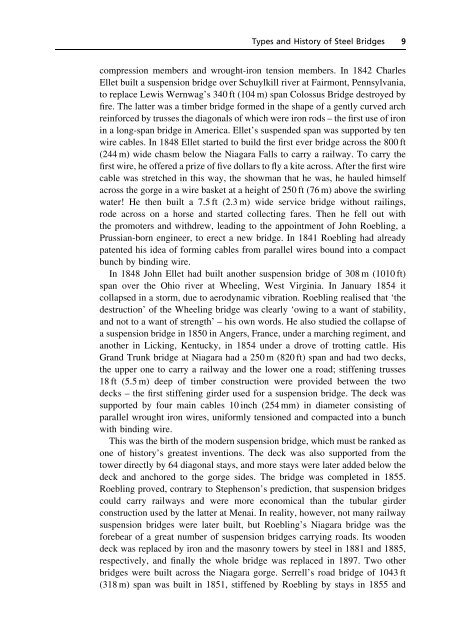The Design of Modern Steel Bridges - TEDI
The Design of Modern Steel Bridges - TEDI
The Design of Modern Steel Bridges - TEDI
You also want an ePaper? Increase the reach of your titles
YUMPU automatically turns print PDFs into web optimized ePapers that Google loves.
Types and History <strong>of</strong> <strong>Steel</strong> <strong>Bridges</strong> 9<br />
compression members and wrought-iron tension members. In 1842 Charles<br />
Ellet built a suspension bridge over Schuylkill river at Fairmont, Pennsylvania,<br />
to replace Lewis Wernwag’s 340 ft (104 m) span Colossus Bridge destroyed by<br />
fire. <strong>The</strong> latter was a timber bridge formed in the shape <strong>of</strong> a gently curved arch<br />
reinforced by trusses the diagonals <strong>of</strong> which were iron rods – the first use <strong>of</strong> iron<br />
in a long-span bridge in America. Ellet’s suspended span was supported by ten<br />
wire cables. In 1848 Ellet started to build the first ever bridge across the 800 ft<br />
(244 m) wide chasm below the Niagara Falls to carry a railway. To carry the<br />
first wire, he <strong>of</strong>fered a prize <strong>of</strong> five dollars to fly a kite across. After the first wire<br />
cable was stretched in this way, the showman that he was, he hauled himself<br />
across the gorge in a wire basket at a height <strong>of</strong> 250 ft (76 m) above the swirling<br />
water! He then built a 7.5 ft (2.3 m) wide service bridge without railings,<br />
rode across on a horse and started collecting fares. <strong>The</strong>n he fell out with<br />
the promoters and withdrew, leading to the appointment <strong>of</strong> John Roebling, a<br />
Prussian-born engineer, to erect a new bridge. In 1841 Roebling had already<br />
patented his idea <strong>of</strong> forming cables from parallel wires bound into a compact<br />
bunch by binding wire.<br />
In 1848 John Ellet had built another suspension bridge <strong>of</strong> 308 m (1010 ft)<br />
span over the Ohio river at Wheeling, West Virginia. In January 1854 it<br />
collapsed in a storm, due to aerodynamic vibration. Roebling realised that ‘the<br />
destruction’ <strong>of</strong> the Wheeling bridge was clearly ‘owing to a want <strong>of</strong> stability,<br />
and not to a want <strong>of</strong> strength’ – his own words. He also studied the collapse <strong>of</strong><br />
a suspension bridge in 1850 in Angers, France, under a marching regiment, and<br />
another in Licking, Kentucky, in 1854 under a drove <strong>of</strong> trotting cattle. His<br />
Grand Trunk bridge at Niagara had a 250 m (820 ft) span and had two decks,<br />
the upper one to carry a railway and the lower one a road; stiffening trusses<br />
18 ft (5.5 m) deep <strong>of</strong> timber construction were provided between the two<br />
decks – the first stiffening girder used for a suspension bridge. <strong>The</strong> deck was<br />
supported by four main cables 10 inch (254 mm) in diameter consisting <strong>of</strong><br />
parallel wrought iron wires, uniformly tensioned and compacted into a bunch<br />
with binding wire.<br />
This was the birth <strong>of</strong> the modern suspension bridge, which must be ranked as<br />
one <strong>of</strong> history’s greatest inventions. <strong>The</strong> deck was also supported from the<br />
tower directly by 64 diagonal stays, and more stays were later added below the<br />
deck and anchored to the gorge sides. <strong>The</strong> bridge was completed in 1855.<br />
Roebling proved, contrary to Stephenson’s prediction, that suspension bridges<br />
could carry railways and were more economical than the tubular girder<br />
construction used by the latter at Menai. In reality, however, not many railway<br />
suspension bridges were later built, but Roebling’s Niagara bridge was the<br />
forebear <strong>of</strong> a great number <strong>of</strong> suspension bridges carrying roads. Its wooden<br />
deck was replaced by iron and the masonry towers by steel in 1881 and 1885,<br />
respectively, and finally the whole bridge was replaced in 1897. Two other<br />
bridges were built across the Niagara gorge. Serrell’s road bridge <strong>of</strong> 1043 ft<br />
(318 m) span was built in 1851, stiffened by Roebling by stays in 1855 and


